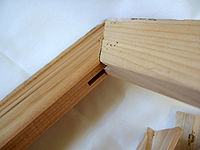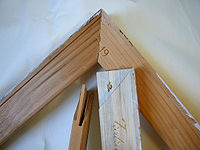
Stretcher bar
Encyclopedia


Picture frame
A picture frame is a decorative edging for a picture, such as a painting or photograph, intended to enhance it, make it easier to display, or protect it.-Construction:...
used by artist
Artist
An artist is a person engaged in one or more of any of a broad spectrum of activities related to creating art, practicing the arts and/or demonstrating an art. The common usage in both everyday speech and academic discourse is a practitioner in the visual arts only...
s to mount their canvas
Canvas
Canvas is an extremely heavy-duty plain-woven fabric used for making sails, tents, marquees, backpacks, and other items for which sturdiness is required. It is also popularly used by artists as a painting surface, typically stretched across a wooden frame...
es. They are traditionally a wooden framework support on which an artist fastens a piece of canvas. They are also used for small-scale embroidery
Embroidery
Embroidery is the art or handicraft of decorating fabric or other materials with needle and thread or yarn. Embroidery may also incorporate other materials such as metal strips, pearls, beads, quills, and sequins....
to provide steady tension, affixing the edges of the fabric with push-pins or a staple gun before beginning to sew, and then removing it from the stretcher when the work is complete. Stretchers are usually in the shape of a rectangle
Rectangle
In Euclidean plane geometry, a rectangle is any quadrilateral with four right angles. The term "oblong" is occasionally used to refer to a non-square rectangle...
, although shaped canvas
Shaped canvas
Shaped canvases are paintings that depart from the normal flat, rectangular configuration. Canvases may be shaped by altering their outline, while retaining their flatness. An ancient, traditional example is the tondo, a painting on a round canvas: Raphael, as well as some other Renaissance...
es are also possible.
Since a stretcher is simply a frame, it can be constructed in a variety of ways. The differences in construction have to do with how the corners are built. Commercially available pre-fabricated stretchers come in segments with interlocking corners, that can be fit together like puzzle pieces. Corner supports can also be made using simple woodworking techniques, however.
The mitre joint is the most popular method of adhering corners on a stretcher, although butt joint
Butt joint
A butt joint is a joinery technique in which two members are joined by simply butting them together. The butt joint is the simplest joint to make since it merely involves cutting the members to the appropriate length and butting them together. It is also the weakest because unless some form of...
s are also fine if used in conjunction with gusset
Gusset
In sewing, a gusset is a triangular or rhomboid piece of fabric inserted into a seam to add breadth or reduce stress from tight-fitting clothing...
s. Keys or small triangle wedges are inserted in the joint after stretching the canvas to give the canvas its final tension. When fastening the canvas, pressure should be distributed evenly around the stretcher to minimize warping due to unequal distribution of pull.
Unlike other types of frames, the corner joints in stretcher bars are not glued or fastened in any permanent way. This allows the canvas to be retensioned over time, as it has a natural tendency to stretch and sag over time. In contrast, strainer bar
Strainer bar
A strainer bar is used to construct a wooden stretcher frame used by artists to mount their canvases. They are traditionally a wooden framework support on which an artist fastens a piece of canvas...
s stretch canvas in a fixed (non-adjustable) way.
The use of stretcher bars in the home print market has become increasingly prominent with inkjet-printed canvas
Canvas print
A canvas print, also known as a stretched canvas or canvas art, is the result of an image printed onto canvas which is stretched, or gallery-wrapped, onto a frame and displayed...
prints becoming more popular in the home. Many print companies import pre-cut and hand-finished stretcher bars from areas of South America
South America
South America is a continent situated in the Western Hemisphere, mostly in the Southern Hemisphere, with a relatively small portion in the Northern Hemisphere. The continent is also considered a subcontinent of the Americas. It is bordered on the west by the Pacific Ocean and on the north and east...
and China
China
Chinese civilization may refer to:* China for more general discussion of the country.* Chinese culture* Greater China, the transnational community of ethnic Chinese.* History of China* Sinosphere, the area historically affected by Chinese culture...
in timbers
Lumber
Lumber or timber is wood in any of its stages from felling through readiness for use as structural material for construction, or wood pulp for paper production....
such as Rosewood Paulownia
Paulownia
Paulownia is a genus of from 6 to 17 species of plants in the monogeneric family Paulowniaceae, related to and sometimes included in the Scrophulariaceae. They are native to much of China, south to northern Laos and Vietnam, and long cultivated elsewhere in eastern Asia, notably in Japan and Korea...
and Fir
Fir
Firs are a genus of 48–55 species of evergreen conifers in the family Pinaceae. They are found through much of North and Central America, Europe, Asia, and North Africa, occurring in mountains over most of the range...
. The rot and warp resistant characteristics of these timbers, as well as their availability in China make them a widely-used choice in machined stretcher bars.
Although artists use blank canvases and pre-stretched canvases in the art business, many photographers use stretcher bars for framing wedding photography and reproduction of photographic prints. Stretcher bars are also used in picture framing when framers are framing things like sport shirts etc. Stretcher bars are used extensively in theatrical productions for framing material backdrops.
When a photographer takes a picture then digitally transfers this onto a canvas (inkjet printing), he then stretches this over a stretcher frame. By wrapping the canvas all the way around the frame, known as gallery wrap, the photographer can then hang his picture on the wall - already framed.
The profiles on the stretcher bar should be slightly rounded. This has two advantages:
1) It allows the framer to see and obtain clear edges on images that have precise borders, and
2) It also allows the canvas weave to "roll over" the profile rather than snap over a sharp edge which is a major cause of canvas cracking.
Most imported Economy bars are available in three profile sizes:-
1) STF or SSB are a Standard Stretcher Bar profile which are 40mm wide and 18mm deep. The unique profile design and 40mm width gives extra strength over longer lengths. This helps prevent "bowing" when stretching the canvas. SSB's are packed 50 units per box.
2) HZF or GSB are a Gallery Stretcher Bar which are also a chunky 35mm wide and 38mm deep. Its sheer strength is obtained from a unique profile design. GSB's are packed 30 units per box.
3) Economy 2 way profile, which is a 42*20 profile and can be used as a standard or a gallery bar. These are available in lengths ready to be mitred.
Professional quality bars are mostly available in four profile sizes. Bars do not twist and will sit perfectly on a flat surface.
1) Pro-Bar Pro (H:18*W:42) - this bar is 18mm deep and 42mm wide
2) Pro-Bar Exhibition (H:38*W:33) - this bar is 38mm deep and 33mm wide.
3) Pro-Bar Museum (H:50*W:38) - this bar is 50mm deep and 38mm wide.
4) Pro-Bar 2way (45*32) - this bar can be used in either profile to create a 32mm or a 45mm deep frame.
These profiles have normally been imported in fir wood but they are now also available in better qualities.
Another way in which stretcher bars can be strengthened is by having a cross brace inserted. It is advised that lengths over 40" or 1m be fitted with a cross brace. By doing this it ensures the wood will not warp and will hang flat
External sources
- Mayer, Ralph. The Artist's Handbook of Materials and Techniques. Viking Adult; 5th revised and updated edition, 1991. ISBN 0-670-83701-6
To stop corners from breaking or warping Stretcher Bars should also be fitted with solid wooden inserts, preferably removeable ones

